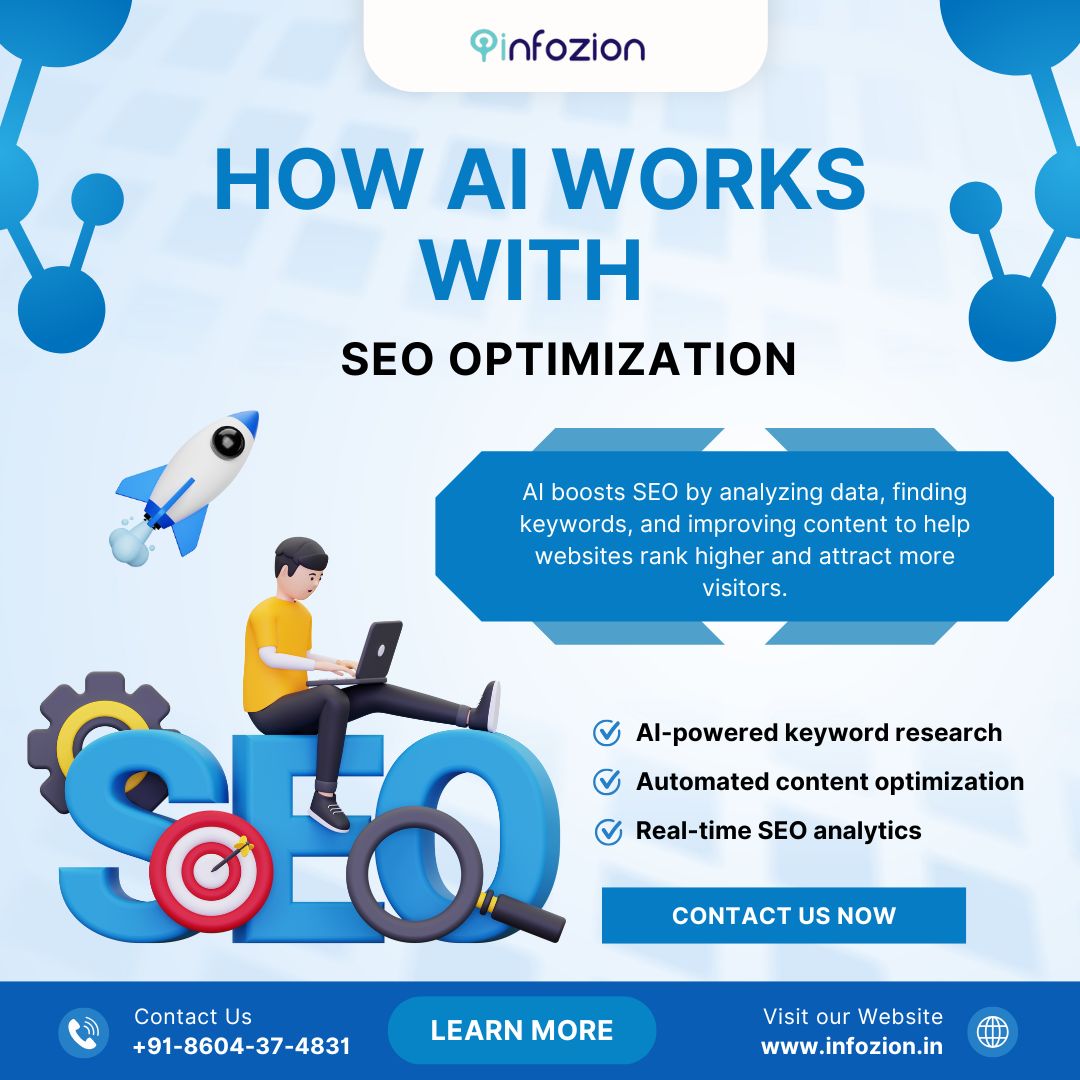How AI Works with SEO Optimization

How AI Works with SEO Optimization
Infozion Technologies uses AI to transform SEO optimization by quickly analyzing search data and user habits. With machine learning and smart tools, Infozion automates keyword research, updates website content, and adapts to evolving search trends, helping businesses achieve higher search rankings and sustained online growth.
Introduction to AI and SEO
Search Engine Optimization, also known as SEO, is what helps websites show up on search engines like Google when someone looks for information. Imagine you want to find “cute puppy pictures”—SEO helps the right websites appear in front of you. Now, there is a technology called Artificial Intelligence, or AI, that makes SEO even better and easier to use.
AI is a special kind of computer program that learns new things, just like a smart robot. It can read lots of information, find patterns, and make good choices to help websites get noticed.
What Is Artificial Intelligence?
Artificial Intelligence means teaching computers to think and make decisions, almost like humans do. If you feed a computer a big set of pictures of dogs and cats, AI learns to tell which is which. The more it learns, the smarter it gets! Many big companies use AI to answer questions, pick favorite movies, and even create drawings or stories.
How AI Helps Websites Rank Higher
SEO is all about making websites easy to find. AI can read lots of websites, learn what works, and help pick the best words or pictures so more people will visit.
Learning What People Search
With AI, computers can notice what words people use in their searches—like “Termite Treatment in Gurgaon” or “best birthday cakes near me.” AI helps websites use these words in the right places, like in titles and descriptions, so search engines show them first.
Making Content Smart
AI can write website articles, suggest new topics, or check if information is easy to read. It can improve spelling and grammar, so visitors have a better experience.
SEO tools powered by AI, such as Yoast SEO and SEMrush, give website owners ideas for improving their posts. For example, they might suggest changing a headline or adding pictures. The computer uses its learning to check thousands of pages very quickly!
Keeping Up With Changes
Search engines sometimes change the rules. AI tools help websites keep up by checking new updates and fixing things before anyone else does. This way, websites stay on top of search results.
Real Life Example — Infozion
A website like Infozion Technologues uses AI-powered SEO tools to get more visitors. If they offer many services, AI helps them choose the best keywords and organize their site, so people searching for those services find their website easily. This makes their business grow faster and smarter!
If you want to learn more about SEO services that use AI, you can also visit Moz for an engaging guide made for beginners.
AI Makes SEO Fun and Easy
For kids and grown-ups alike, AI makes website optimization a lot less confusing. It finds patterns, checks for mistakes, and tells website owners what to do next. The more websites use AI, the better they can help people find what they are looking for—just like magic!
Why Website Owners Love AI SEO Optimization
AI saves lots of time by doing boring jobs like reading thousands of words and picking up smart ideas. It also helps make websites safer, faster, and more fun to use.
When AI works with SEO optimization, everyone benefits. Websites get more visitors, and people find answers faster, whether it’s for homework, shopping, or solving problems.
Conclusion
AI and SEO work together to make websites successful. Even young students can see how computers that learn can help smart ideas get seen by thousands of people.
From choosing keywords to fixing grammar, AI is the secret helper behind many top-ranking sites. If you build a website and want everyone to see it, using AI-powered SEO tools is a great way to start!
How Companies Can Tap into Machine Learning Predictive Maintenance and Win Big
In today’s competitive landscape, every hour of downtime costs money and customer trust. That’s why more companies are turning to machine learning (ML)–powered predictive maintenance to transform equipment reliability from a constant risk into a strategic advantage.
Why Predictive Maintenance Matters
Traditional maintenance models are either reactive (fixing equipment after it fails) or preventive (servicing machines on a schedule). Both approaches can be costly—either from unexpected breakdowns or unnecessary part replacements.
Predictive maintenance changes the game. By using machine learning to analyze sensor data—like temperature, vibration, or energy consumption—companies can detect issues before they become failures. This reduces downtime, cuts costs, and extends asset lifespan.
Real-World Wins with Predictive Maintenance
Across industries, companies are seeing measurable benefits:
- Manufacturing – Early fault detection reduces unexpected downtime and increases production efficiency.
- Transportation & Logistics – Predictive models help fleets avoid costly breakdowns, improving delivery reliability.
- Healthcare – Hospitals use predictive maintenance on MRI and CT machines to ensure critical uptime for patient care.
- Telecommunications – Network providers minimize outages by predicting router or base station failures.
- Energy – Power plants leverage ML models to prevent turbine failures, saving millions in lost energy output.
Roadmap for Implementation
- Start with a Pilot Project
Select one critical asset to collect data from and test predictive models. Small wins build momentum. - Build a Cross-Functional Team
Data scientists, IT, and maintenance experts must collaborate for practical success. - Make the Business Case
Show leadership how predictive maintenance translates into cost savings and reduced downtime. - Use the Right Technology Mix
Balance real-time edge analytics with cloud-based data storage and ML training. - Pick the Right Algorithms
Anomaly detection, regression models, or neural networks—each fits different use cases. - Measure, Learn, Improve
Track KPIs such as Mean Time Between Failures (MTBF), unplanned downtime reduction, and accuracy of predictions. - Scale Strategically
Expand the approach across more assets once the pilot proves its value.
Overcoming Common Challenges
- Data Quality – Poor or inconsistent data limits results. Cleaning and governance are essential.
- System Integration – Legacy equipment may not easily connect. APIs and IoT gateways help.
- Alarm Fatigue – Too many alerts create noise. Use intelligent filtering and prioritization.
- Cultural Adoption – Maintenance teams need training and trust in AI-driven insights.
Why Now Is the Right Time
The global predictive maintenance market is projected to grow exponentially over the next few years. With falling sensor costs, accessible cloud platforms, and maturing ML algorithms, the barrier to entry has never been lower. Companies that act now can gain a competitive edge and secure long-term savings.
Conclusion
Predictive maintenance powered by machine learning isn’t just about preventing failures—it’s about unlocking efficiency, reliability, and profit. Companies that start small, measure impact, and scale effectively will turn downtime into opportunity and win big in the digital age.
Resources
- JustSoftLab – How companies can tap into machine learning predictive maintenance and win big
- NILG.AI – Machine Learning for Predictive Maintenance
- ITRex Group – Machine Learning Predictive Maintenance
Intelligence at Scale: Data Monetization in the Age of Gen AI
Introduction: The Shift from Data to Intelligence
In today’s AI-driven world, Intelligence at scale: Data monetization with Gen AI is reshaping business models. Traditional models focused on selling raw or aggregated data are faltering. Instead, companies are turning to generative AI (Gen AI) to push beyond analytics and build intelligence-rich data products. This strategic shift enables organizations to unlock deeper insight, automate action, and create new revenue streams.
Why Intelligence Is the New Currency
From Static Data to Actionable Insights
With Gen AI, businesses no longer need to stop at dashboards or reports. Intelligence emerges when AI transforms raw data—especially unstructured sources like documents, voice transcripts, or social media—into contextual recommendations, integrated directly into business workflows. This move from “insight” to “intelligence” drives more impactful decisions and unlocks higher value.
Real-World Example: Walmart’s Scintilla
Take Walmart’s Scintilla (formerly Luminate): a data product built on shopper behavior. In just one year, the product’s revenue grew 80% quarter over quarter, with a 173% year-on-year growth in customers and a perfect renewal rate—all thanks to AI-powered intelligence embedded in supplier workflows.
The DIKW Pyramid—Accelerated by Gen AI
The classic DIKW (Data → Information → Knowledge → Wisdom) model illustrates progression:
-
Data: Raw, unorganized inputs.
-
Information: Cleaned, organized summaries and charts.
-
Knowledge: Patterns and trends with context.
-
Wisdom: Judgment-driven, actionable insights.
Gen AI propels organizations up this pyramid rapidly—especially by unlocking unstructured data and connecting it in real time to drive intelligent outcomes.
Modern Models of Data Monetization
The Pressures on Traditional Data Brokerage
Raw data is becoming commoditized, privacy regulations are tightening, and synthetic data options are emerging. By 2026, it’s predicted that 75% of businesses will leverage Gen AI to create synthetic customer data—up from under 5% in 2023. These shifts put pressure on old-school data resale models and force innovation.
Intelligence-Driven Products and Agentic AI
Gen AI enables companies to create intelligent data products—for example:
-
Personalized content: Automotive firms, using Gen AI, built lead engines that boosted qualified leads by 15–25% and increased parts/service sales by 25–30%.
-
Real-time decision-making: In banking, AI tools optimize collections—identifying who to contact, when, and how—improving prompt-to-pay outcomes.
-
Agentic AI: Fully autonomous systems embedded into workflows can coordinate real-time actions (e.g., e-commerce upsells, intelligent API-based knowledge services) with human oversight.
Building a Scalable, Intelligence-Driven Data Business
Organizations follow a typical maturity curve:
-
Internal Optimization: Use Gen AI internally for automation and efficiency.
-
Opportunistic Monetization: Offer AI-generated insights externally in tailored formats.
-
Full Marketplace Monetization: Launch standalone intelligence products with strong GTM models.
To succeed, organizations need six foundational pillars:
1. Strategy & Product
Define what makes your data uniquely valuable—whether proprietary access, domain expertise, or customer context. Build your intelligence strategy grounded in competitive advantage.
2. Go-to-Market & Growth
Adopt flexible pricing models—usage-based, outcome-based, or tiered—and shift customer success from support to strategic partnership. Embed Gen AI products into partner ecosystems for broader reach.
3. Technology & Data Architecture
Leverage cloud-native, scalable infrastructure with modular design. Support both structured and unstructured data, multi-agent systems, and robust governance frameworks for trustworthy AI delivery.
4. People
Assemble cross-functional teams—engineers, product leads, commercial strategists—and invest in talent development. Internal upskilling and clear career paths are key.
5. Operations & Management
Plan for LLM governance, versioning, observability, and regulatory compliance. Ensure operational readiness across support, legal, finance, and risk functions as your AI products scale.
6. Capital & Responsible AI
Be mindful of compute costs, model retraining, and performance degradation over time. Align capital deployment with product maturity and adoption levels, while embedding ethical frameworks and monitoring mechanisms.
The Future: Intelligent Ecosystems & Synthetic Data Exchanges
Looking ahead, we can expect:
-
Self-learning assets that dynamically adapt to market trends.
-
AI agents negotiating in data marketplaces, prioritizing value-driven pricing rather than volume.
-
Synthetic data exchanges, where AI-generated datasets reduce regulatory risk and open new avenues for safe data monetization.
Intelligence—not raw data—will be the defining competitive asset of the digital economy.
For a deeper understanding of modern data architecture and how to prepare for next-gen data products, check out McKinsey’s insights on revisiting data frameworks: Read more
Explore intelligent digital transformation and AI services via Infozion: Learn more





